Fact Sheet FS1308
This publication is intended for homeowners and other non-professionals with lawns of cool-season turfgrass species such as perennial ryegrass (Lolium perenne), tall fescue (Schedonorus arundinaceus), fine fescues (Festuca spp.), or bluegrass (Poa spp.). These turfgrass species are commonly found in New Jersey and much of the northern United States. If you are a professional turfgrass manager see FS1309, Crabgrass and Goosegrass Identification and Control in Cool-Season Turfgrass for Professionals.
Introduction and Identification
Crabgrass
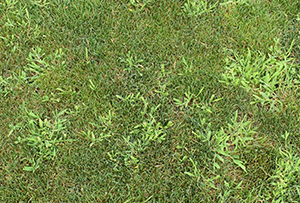
Figure 1. Crabgrass in a lawn. Notice the coarse texture and light green color of crabgrass compared to the surrounding cool-season turfgrass.
Crabgrass (Digitaria spp.) is a true annual in the northeastern United States (Figure 1). Seeds germinate in the spring and seedlings grow rapidly throughout the summer as a warm-season (C4) plant. At maturity in late summer, plants produce seed before dying at the first frost in autumn. Each plant can produce thousands of seeds that remain viable in the soil for several years, making this annual weed a perennial problem.
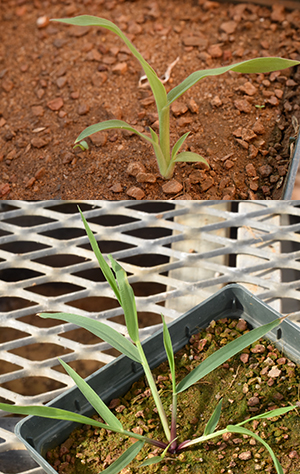
Figure 2. Smooth crabgrass and large crabgrass. Notice the hairs along the stem and leaves of large crabgrass, while the smooth crabgrass has a purple stem and is hairless.
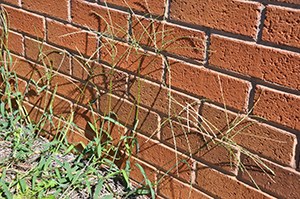
Figure 3. Smooth crabgrass seedhead.
Smooth and large crabgrass (Digitaria ischaemum and D. sanguinalis, respectively) are the most common crabgrass species found in the northeastern United States (Figure 2). Crabgrass has a rolled stem (rolled vernation) and lime green, coarse-textured leaves. It typically has a prostrate growth habit, spreading out along the ground. Crabgrass seedheads appear finger-like with spikes (racemes) arising from different points at the top of the stem (Figure 3). The leaves and leaf sheaths of large crabgrass are typically covered in dense hairs while those of smooth crabgrass are hairless (glabrous) and purple at the base. In the northeastern and mid-Atlantic regions, smooth crabgrass is more prevalent than large crabgrass.
Other Summer Annuals
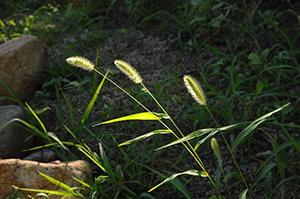
Figure 4. Foxtails with seedheads.
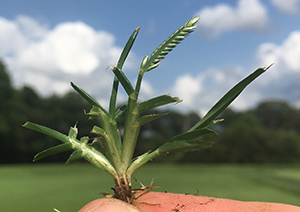
Figure 5. Goosegrass plant.
Crabgrass is the most common summer annual grassy weed of cool-season home lawns, but other summer annuals such as foxtail (Setaria spp.) and goosegrass (Eleusine indica) can be found occasionally. Foxtails are most easily identified in late summer once plants produce a seedhead that contains bristly awns (Figure 4). Goosegrass is another summer annual that, although not common in home lawns, is prevalent in parks and sports fields with highly trafficked, compacted soil. Goosegrass is most easily identified by a whitish, flattened stem (folded vernation) and prostrate growth habit (Figure 5). The seeds are arranged in a herringbone pattern on the seedhead spike.
Controlling Crabgrass and other Summer Annual Weeds
A dense stand of turfgrass is the most effective way to prevent summer annual weeds. Supply adequate nitrogen fertility (often 2 to 3 fertilizer applications per year in New Jersey), other nutrients, and lime as determined by a soil test to maintain a dense canopy of desirable turfgrass. Apply nitrogen fertilizer in early autumn and, if needed, in the spring when cool-season grasses are more competitive than these warm-season weeds. Applying nitrogen fertilizer from mid-June through mid-August will promote the growth of crabgrass and other summer annual weeds more than the desirable turfgrass.
Research shows that mowing at the highest height recommended for your particular turfgrass species can significantly reduce crabgrass infestations compared to a low mowing height. Combining a higher height of cut with proper fertilization will create a dense turfgrass canopy that will shade the soil and make it more difficult for weed seedlings to survive.
If an irrigation system is available, irrigate deep and infrequently (once or twice per week), and only when the desirable turfgrass exhibits initial signs of drought stress. In New Jersey, grasses mowed at > 2.5 inches rarely need supplemental irrigation in the springtime. Frequent irrigation is not desirable as it keeps the surface of the soil moist and encourages weed seedlings to survive.
Where severe crabgrass infestations are present in summer, a late summer or early autumn seeding of desirable cool-season turfgrass is a valuable management practice. Seeding at this time will fill the voids created when these annual weeds die and result in a dense turfgrass canopy that prevents weed seedling survival the following spring. For more information on turfgrass fertilization and seeding see FS108, Renovating Your Lawn and E327, Best Management Practices for Nutrient Management of Turf in New Jersey.
Mechanical Removal
Minor infestations common along sidewalks or other areas where the lawn is thin can often be managed by hand removal rather than herbicides. It is important to remove plants before seed is produced. Crabgrass and foxtails have a fibrous root system and the plant crowns (basal growing point) can be easily removed by hand or an upright weeding tool when the plants are small. Plants will not regrow if the crown of plants is removed. As crabgrass matures it can root at nodes on stems growing along the ground. Goosegrass can be removed mechanically when it is immature, but as the plant matures and the central taproot develops it becomes more difficult to remove. Since seeds can germinate through the summer months, hand removal several times during this period may be necessary.
Herbicide Options
In areas with a history of infestations that cannot be managed with cultural practices and mechanical removal alone, herbicides are an effective and economical option when applied at the proper time and rate. These products are safe when used according to directions. It is especially important to sweep the product off of sidewalks, roads, and other hardscapes to prevent runoff.
Pre-Emergent Herbicides
Especially in areas with a history of moderate to severe infestations, pre-emergence herbicides are more economical and effective than post-emergence herbicides. Pre-emergence herbicides should be applied and watered into the soil before crabgrass germinates in the spring. Most pre-emergent herbicides will not control crabgrass after it germinates. These herbicides do not control other summer annual weeds such as goosegrass or foxtail as well as crabgrass.
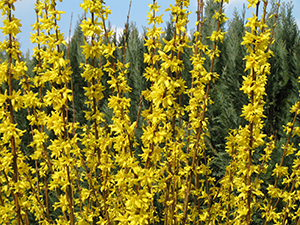
Figure 6. A forsythia shrub in full bloom and closer view of the flowering branches (inset).
Crabgrass typically germinates mid to late April in central and northern New Jersey and early to mid-April in southern parts of the state. Forsythia is an excellent phenological indicator for crabgrass germination (Figure 6). When forsythia is in full bloom, crabgrass pre-emergent herbicides should be applied as soon as possible. Foxtails typically germinates 3 to 4 weeks after crabgrass.
Pre-emergent herbicides should be applied to well-established, mature turfgrass. Do not apply any of the pre-emergence herbicides listed below if you plan to seed several weeks after the application, as these herbicides will kill turfgrass seed. See the product label for more information on use before or after seeding, even if seeding was conducted the previous autumn. Products listed below are safe on most cool-season turfgrasses, but always refer to the label for turfgrass tolerance information especially where fine fescue (Festuca spp.) is desired.
Most products are equally effective if applied uniformly at the proper rate. Poor application uniformity and/or using too little product are common causes of pre-emergence herbicide failure. For example, if the product bag indicates that the product covers a 5,000 square foot lawn and you use it to cover 7,500 feet, do not expect the product to provide excellent crabgrass control. Immediate irrigation or rainfall after application is not usually necessary (unless crabgrass germination is imminent), but is typically recommended within 2 to 7 days after application. Carefully follow the product instructions for best results.
Effective pre-emergent herbicides (often listed as crabgrass preventers) are listed below based on their active ingredient. Most pre-emergent herbicides are available as a granular (with or without fertilizer) that can be applied through a rotary or drop spreader. Products listed below are commonly found in the garden center of both small and large retail stores. The list below is not comprehensive but represents active ingredients that are most effective for crabgrass control. Brand names change frequently. Read the fine print on the product label to find the active ingredient which is the most important indicator of product effectiveness.
| Active Ingredient | Brand Names | Notes |
|---|---|---|
| pendimethalin | Scotts Step 1 or Halts Crabgrass Preventer, Vigoro Crabgrass Preventer | In areas with a history of severe crabgrass infestations or sandy soils, consider applying once in the spring before crabgrass germinates and again in early June. |
| dithiopyr | Dimension, Bonide Crabgrass and Weed Preventer, Greenview, Preen Lawn Crabgrass Control, Jonathan Green Green-Up with Crabgrass Preventer, Scotts Snap Pac Crabgrass Preventer, Spectracide Weed Stop for Lawns | The active ingredient dithiopyr is unique in that it can control crabgrass even if applied up to 4 weeks after germination. See the label for more information on the application rate especially if applying after crabgrass germination. Delaying the application to take advantage of this early post-emergence control will extend the crabgrass control further into the summer. Utilizing this delayed strategy may be especially important in sandy soils. Dithiopyr does not provide early post-emergence control of other weeds. Many products that contain dithiopyr can also be used in ornamental beds. |
| prodiamine | Barricade | A single application typically provides season long crabgrass control. In areas with a history of severe crabgrass infestations or sandy soils, consider applying once in the spring before crabgrass germinates and again in early June. In lawns that are predominately fine fescue, over-application can cause injury. Read the label carefully before applying in fine fescue. |
| mesotrione | Scotts Turf Builder Starter Food for New Grass Plus Weed Preventer | Mesotrione has less residual efficacy than other pre-emergence herbicides but can be safely applied at and shortly after seeding many cool-season turfgrass species. When applied at seeding it will provide pre-emergence crabgrass control up to four weeks. This product is especially useful for weed control if you are seeding in the springtime. Mesotrione will often cause new seedlings to appear bleached, but they typically recover within 2 weeks. Be careful not to over-apply, especially to seed mixtures that are predominantly fine fescue. Do not apply to zoysiagrass (Zoysia spp.). |
| siduron | Tupersan, Jonathan Green Crabgrass Preventer Plus New Seeding Lawn Fertilizer, others | Similar to mesotrione, siduron has less residual efficacy than other pre-emergence herbicides but can be safely applied at and shortly after seeding many cool-season turfgrass species. Siduron is generally less effective than mesotrione but will provide pre-emergence crabgrass control up to four weeks. Use at the highest recommended rate for best crabgrass control. Siduron is especially useful for weed control if you are seeding in the springtime. |
Post-Emergence Herbicides
In areas with a history of moderate to severe infestations, it is more economical and effective to rely primarily on pre-emergence herbicides and use post-emergence herbicides where plants "escape" the pre-emergence herbicide. Relying exclusively on post-emergence herbicides is recommended only if pre-emergence herbicides are not an option or in areas with a history of very minor crabgrass infestations.
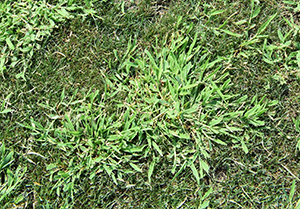
Figure 7. Two smooth crabgrass plants with many tillers as commonly observed in mid-summer.
Post-emergence herbicide effectiveness is highly dependent on crabgrass growth stage. Small plants commonly found before early July are much easier to control than plants that have multiple stems (tillers). Crabgrass typically begins to tiller and mature rapidly beginning in mid to late June (Figure 7). From early July through mid-August, effective post-emergence control will often require multiple applications on a 2- to 3-week interval. Post-emergence herbicide efficacy usually improves again in late August once plants mature and temperatures cool. If you did not apply a pre-emergence herbicide, it is a good idea to scout the lawn for small crabgrass plants in mid-June and apply an herbicide if necessary.
Post-emergence herbicides are most often applied as a spray either through a hose-end or pump-type sprayer. The herbicide must be absorbed by the plant leaves to kill the weed. Apply these herbicides under ideal growing conditions. If the lawn is under drought or heat stress, herbicides will be less effective and may injure the turfgrass.
Herbicides listed below are safe to most cool-season turfgrass species if applied properly. Always check the label to make sure the product is safe for use on the grass species in your lawn.
| Active Ingredient | Brand Names | Notes |
|---|---|---|
| fenoxaprop-p-ethyl | Bioadvanced (formerly Bayer Advanced) Crabgrass Killer for Lawns | This herbicide may cause temporary stunting or yellowing to Kentucky bluegrass. Do not apply herbicides such as 2,4-D, MCPA, or MCPP for broadleaf weed control within 5 days before or 21 days after a fenoxaprop application or it will not control crabgrass. Fenoxaprop will not provide good weed control if the plants are drought stressed. Fenoxaprop controls most summer annual grassy weeds including crabgrass. |
| quinclorac | Bonide Weed Beater Plus Crabgrass Control, Ortho Weed-B-Gon Plus Crabgrass Control, RoundUp for Lawns 3, Spectracide Weed Stop for Lawns Plus Crabgrass Killer | Quinclorac also provides excellent control of some broadleaf weeds such as white clover (Trifolium repens). If your lawn is predominantly fine fescue this product may not be safe. Read the product label carefully before applying. Quinclorac controls many summer annual grassy weeds, but does not control goosegrass. |
Organic Herbicides
Organic herbicides are not as effective or consistent as synthetic herbicides. In an organic system, utilizing proper cultural practices is of the utmost importance. This includes mowing at the highest recommended height (typically 3 to 5 inches) for the turfgrass species in your lawn as well as proper fertilization, irrigation, and seeding discussed earlier in this publication.
Pre-Emergence Herbicides
Products that contains corn gluten meal or corn gluten hydrolysate rarely provide acceptable control of severe crabgrass infestations. It is worth noting that corn gluten meal contains a substantial amount of nitrogen fertilizer, which can increase turfgrass density and reduce crabgrass infestations. There are other products sold for crabgrass control that contain soybean or other horticultural oils. We have not observed crabgrass control from these products in our research.
Post-Emergence Herbicides
Organic post-emergence herbicides are typically non-selective and may provide control of small crabgrass plants, but these products will also injure or kill surrounding turfgrass that is contacted by the herbicide. Effectiveness of most organic herbicides is highly dependent on environmental conditions. Better control occurs as relative humidity and air temperature increase.
Conclusions
Effective crabgrass control requires a healthy and dense lawn. In lawns with a history of moderate to severe crabgrass infestations, proper herbicide selection and application is also important. Knowing the weed history of a particular site can help you develop an economical and effective strategy. For example, on a site with a history of moderate to severe infestations, a pre-emergence herbicide is important. In this situation it is also likely that spot treatment with a post-emergence herbicide will be necessary, especially if the turfgrass canopy thins in mid-summer due to biotic or abiotic stress. In sites with a history of minor infestations and good turfgrass cover you can expect pre-emergence herbicides to be very effective or choose to rely exclusively on mechanical removal and/or spot treatment with post-emergence herbicides.
Always read the label very carefully before applying any product to your lawn. Pay careful attention to which turfgrass species the product can be applied and how to apply the product for maximum effectiveness and safety around humans and pets.
Photo credits: Matt Elmore (Figure 1, 2, and 5–7), Eric Reasor (Figure 3), Max Pixel (Figure 4).
Mention or display of a trademark, proprietary product, or firm in text or figures does not constitute an endorsement by Rutgers Cooperative Extension and does not imply approval to the exclusion of other suitable products or firms.
August 2019
Copyright © 2024 Rutgers, The State University of New Jersey. All rights reserved.
For more information: njaes.rutgers.edu.
Cooperating Agencies: Rutgers, The State University of New Jersey, U.S. Department of Agriculture, and Boards of County Commissioners. Rutgers Cooperative Extension, a unit of the Rutgers New Jersey Agricultural Experiment Station, is an equal opportunity program provider and employer.

